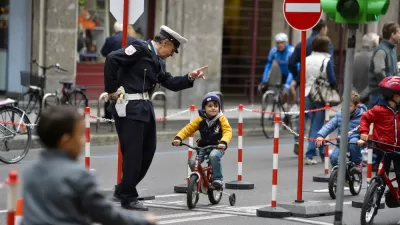The Governors Highway Safety Association released a report titled Bicyclist Safety showing a surge in bike fatalities since 2010. The report provoked widespread media coverage and, also, strongly critical reactions.
The Governors Highway Safety Association's Bicyclist Safety report claims bike fatalities spiked by 16 percent between 2010 and 2012. From the press release announcing the report: "The number of bicyclists killed on U.S. roadways is trending upward, particularly for certain subsets of the population....yearly bicyclist deaths increased 16 percent between 2010 and 2012, while overall motor vehicle fatalities increased just one percent during the same time period."
Michael Andersen and Tanya Snyder counter the claims of the report by noting that the bike fatalities nationwide are lower than historic highs set in 1975—even though bike ridership is currently soaring. So, "what’s actually happening is that for an infinitesimal fraction of the cost of the nation’s transportation system, Americans are enjoying billions more bike trips every year than they were a generation ago. And because the sheer number of bikes on the street is teaching drivers to keep an eye out for bikes, every single bike trip is far, far safer than it was." Andersen and Snyder make a number of other convincing arguments refuting the methodology and rhetoric of the report.
Anderson and Snyder note that the GHSA's report was picked up by the Des Moines Register, NJ.com, and the Washington Post. Planetizen notes that it was also picked up by Governing and the San Jose Mercury News.
Andersen and Snyder conclude with this appeal: "Reporters and editors treat the GHSA with respect because it describes itself as 'The States’ Voice on Highway Safety.' State officials who are interested in helping their residents safely enjoy the benefits of biking might want to consider whether, on this issue, the GHSA is actually speaking for them."
FULL STORY: Don’t Believe the Headlines: Bike Boom Has Been Fantastic for Bike Safety

Planetizen Federal Action Tracker
A weekly monitor of how Trump’s orders and actions are impacting planners and planning in America.

San Francisco's School District Spent $105M To Build Affordable Housing for Teachers — And That's Just the Beginning
SFUSD joins a growing list of school districts using their land holdings to address housing affordability challenges faced by their own employees.

The Tiny, Adorable $7,000 Car Turning Japan Onto EVs
The single seat Mibot charges from a regular plug as quickly as an iPad, and is about half the price of an average EV.

As Trump Phases Out FEMA, Is It Time to Flee the Floodplains?
With less federal funding available for disaster relief efforts, the need to relocate at-risk communities is more urgent than ever.

With Protected Lanes, 460% More People Commute by Bike
For those needing more ammo, more data proving what we already knew is here.

In More Metros Than You’d Think, Suburbs are Now More Expensive Than the City
If you're moving to the burbs to save on square footage, data shows you should think again.
Urban Design for Planners 1: Software Tools
This six-course series explores essential urban design concepts using open source software and equips planners with the tools they need to participate fully in the urban design process.
Planning for Universal Design
Learn the tools for implementing Universal Design in planning regulations.
Smith Gee Studio
City of Charlotte
City of Camden Redevelopment Agency
City of Astoria
Transportation Research & Education Center (TREC) at Portland State University
US High Speed Rail Association
City of Camden Redevelopment Agency
Municipality of Princeton (NJ)




























